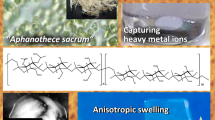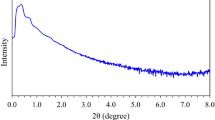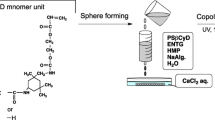Abstract
Silver or gold-containing porous frameworks have been used extensively in catalysis, electrochemistry, heat dissipation and biofiltration1,2,3. These materials are often prepared by thermal reduction of metal-ion-impregnated porous insoluble supports (such as alumina and pumice), and have surface areas of about 1 m2 g−1, which is typically higher than that obtained for pure metal powders or foils prepared electrolytically4 or by infiltration and thermal decomposition of insoluble cellulose supports5. Starch gels have been used in association with zeolite nanoparticles to produce porous inorganic materials with structural hierarchy6, but the use of soft sacrificial templates in the synthesis of metallic sponges has not been investigated. Here we demonstrate that self-supporting macroporous frameworks of silver, gold and copper oxide, as well as composites of silver/copper oxide or silver/titania can be routinely prepared by heating metal-salt-containing pastes of the polysaccharide, dextran, to temperatures between 500 and 900 °C. Magnetic sponges were similarly prepared by replacing the metal salt precursor with preformed iron oxide (magnetite) nanoparticles. The use of dextran as a sacrificial template for the fabrication of metallic and metal oxide sponges should have significant benefits over existing technologies because the method is facile, inexpensive, environmentally benign, and amenable to scale-up and processing.
This is a preview of subscription content, access via your institution
Access options
Subscribe to this journal
Receive 12 print issues and online access
$259.00 per year
only $21.58 per issue
Buy this article
- Purchase on Springer Link
- Instant access to full article PDF
Prices may be subject to local taxes which are calculated during checkout




Similar content being viewed by others
References
Jin, X.B, Zhuang, L. & Lu J.T. Determination of the ionic resistance in a porous electrode using chronocoulometry. J. Electroanal. Chem. 519, 137–144 ( 2002).
Busch, P.A., Cheston, S.P. & Greywall, D.S. Properties of sintered-silver heat-exchangers. Cryogenics 24, 445–447 ( 1984).
Padilla, A.P., Rodriguez, J.A. & Saitua, H.A. Synthesis and water ultrafiltration properties of silver membrane supported on porous ceramics. Desalination 114, 203–208 ( 1997).
Reuss, G, Disteldorf, W., Grundler, O. & Hilt, A. in Ullman's Encyclopedia of Industrial Chemistry 6th edn Vol. 15 1–34 (Wiley-VCH, Weinheim, 2002).
Erdoelchemie GMBH. Porous oxidation catalysts. GB patent 1,074,017 ( 1967).
Zhang, B.J., Davis, S.A. & Mann, S. Starch gel templating of spongelike macroporous silicalite monoliths and mesoporous films. Chem. Mater. 14, 1369–1375 ( 2002).
Rebsdat, S. & Mayer, D. in Ullman's Encyclopedia of Industrial Chemistry 6th Edition Vol. 12 609–636 (Wiley-VCH, Weinheim, 2002).
Thompson, D.T. New advances in gold catalysis Part I. Gold Bull. 31, 111–118 ( 1998).
Thompson, D.T. New advances in gold catalysis Part II. Gold Bull. 32, 12–19 ( 1999).
Bond, G.C. & Thompson, D.T. Gold-catalysed oxidation of carbon monoxide. Gold Bull. 33, 41–51 ( 2000).
Burke, L.D. & Nugent, P.F. Dichromate reduction of gold and platinum electrodes in aqueous acid solutions. Electrochim. Acta 42, 399–411 ( 1997).
Bond, G.C. & Thompson, D.T. Catalysis by gold. Catal. Rev. Sci. Eng. 41, 319–388 ( 1999).
van Noort, D. & Mandenius, C.F. Porous gold surfaces for biosensor applications. Biosens. Bioelectron. 15, 203–209 ( 2000).
Erlebacher, J. et al. Evolution of nanoporosity in dealloying. Nature 410, 450–453 ( 2001).
Acknowledgements
We gratefully acknowledge the EPSRC (Engineering and Physical Sciences Research Council) UK and JST (CREST) Japan for financial support of this study.
Author information
Authors and Affiliations
Corresponding author
Ethics declarations
Competing interests
The authors have submitted a patent based on the reported work.
Supplementary information
Figure S1 X-ray diffractograms of prepared framework materials.
Figure S2 BET isotherms of silver sponge samples heated at 520, 600, 700, 800 or 900°C. (PDF 839 kb)
Figure S3 TGA profile for a silver nitrate/dextran paste heated at 5°C/ min in air showing a marked weight loss of 59 % at 167°C.
Figure S4 SEM micrographs of silver sponge prepared with low and high Mr dextran.
Figure S5 SEM micrograph of silver sponge containing voids due to acid dissolution of localised copper oxide particles.
Figure S6 SEM micrograph and elemental maps of mixed silver and copper sponge.
Rights and permissions
About this article
Cite this article
Walsh, D., Arcelli, L., Ikoma, T. et al. Dextran templating for the synthesis of metallic and metal oxide sponges. Nature Mater 2, 386–390 (2003). https://doi.org/10.1038/nmat903
Received:
Accepted:
Published:
Issue Date:
DOI: https://doi.org/10.1038/nmat903
This article is cited by
-
Emulsion templated amino functionalised polymeric monolith filter for innovative air purification technology
Journal of Porous Materials (2020)
-
Extracellular polysaccharides produced by bacteria of the Leuconostoc genus
World Journal of Microbiology and Biotechnology (2020)
-
Facile and Scalable Fabrication of Highly Porous Co3O4 and α-Fe2O3 Nanosheets and Their Catalytic Properties
Journal of Electronic Materials (2019)
-
Hierarchically porous materials: Synthesis strategies and emerging applications
Frontiers of Chemical Science and Engineering (2016)



